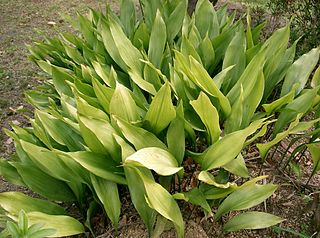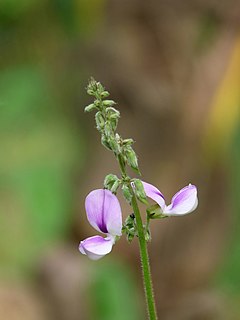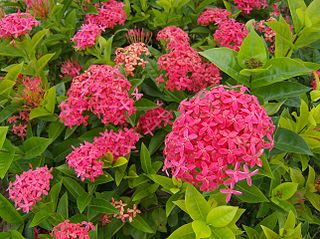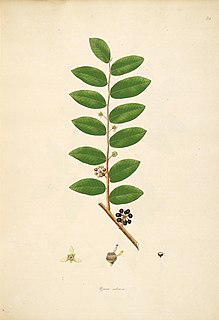
Aspidistra is a genus of flowering plants in the family Asparagaceae, subfamily Nolinoideae, native to eastern and southeastern Asia, particularly China and Vietnam. They grow in shade under trees and shrubs. Their leaves arise more or less directly from ground level, where their flowers also appear. The number of species known has increased considerably from the 1980s onwards, with around 100 accepted as of July 2013. Aspidistra elatior is common worldwide as a foliage house plant that is very tolerant of neglect. It and other species can also be grown in shade outside, where they are generally hardy to −5 °C (23 °F).

The buntings are a group of Old World passerine birds forming the genus Emberiza, the only genus in the family Emberizidae. The family contains 45 species. They are seed-eating birds with stubby, conical bills.

The Casuarinaceae are a family of dicotyledonous flowering plants placed in the order Fagales, consisting of four genera and 91 species of trees and shrubs native to eastern Africa, Australia, Southeast Asia, Malesia, Papuasia, and the Pacific Islands. At one time, all species were placed in the genus Casuarina. Lawrence Alexander Sidney Johnson separated out many of those species and renamed them into the new genera of Gymnostoma in 1980 and 1982, Allocasuarina in 1982, and Ceuthostoma in 1988, with some additional formal descriptions of new species in each other genus. At the time, it was somewhat controversial. The monophyly of these genera was later supported in a 2003 genetics study of the family. In the Wettstein system, this family was the only one placed in the order Verticillatae. Likewise, in the Engler, Cronquist, and Kubitzki systems, the Casuarinaceae were the only family placed in the order Casuarinales.

Heinrich Wilhelm Schott was an Austrian botanist well known for his extensive work on aroids (Araceae).

Daphne is a genus of between 70 and 95 species of deciduous and evergreen shrubs in the family Thymelaeaceae, native to Asia, Europe and north Africa. They are noted for their scented flowers and often brightly coloured berries. Two species are used to make paper. Many species are grown in gardens as ornamental plants; the smaller species are often used in rock gardens. All parts of daphnes are poisonous, especially the berries.

Pueraria is a genus of 15–20 species of legumes native to Asia. The best known member is kudzu, also called Japanese arrowroot. The genus is named after 19th century Swiss botanist Marc Nicolas Puerari.

Acacia, commonly known as the wattles or acacias, is a large genus of shrubs and trees in the subfamily Mimosoideae of the pea family Fabaceae. Initially, it comprised a group of plant species native to Africa and Australasia. The genus name is New Latin, borrowed from the Greek ἀκακία, a term used by Dioscorides for a preparation extracted from the leaves and fruit pods of Vachellia nilotica, the original type of the genus. In his Pinax (1623), Gaspard Bauhin mentioned the Greek ἀκακία from Dioscorides as the origin of the Latin name.

Ixora is a genus of flowering plants in the family Rubiaceae. It is the only genus in the tribe Ixoreae. It consists of tropical evergreen trees and shrubs and holds around 544 species. Though native to the tropical and subtropical areas throughout the world, its centre of diversity is in Tropical Asia. Ixora also grows commonly in subtropical climates in the United States, such as Florida where it is commonly known as West Indian jasmine. Other common names include viruchi, kiskaara, kepale, rangan, kheme, ponna, chann tanea, techi, pan, siantan, jarum-jarum/jejarum, jungle flame, jungle geranium, and cruz de Malta, among others. The plants possess leathery leaves, ranging from 3 to 6 inches in length, and produce large clusters of tiny flowers in the summer. Members of Ixora prefer acidic soil, and are suitable choices for bonsai. It is also a popular choice for hedges in parts of South East Asia. In tropical climates they flower year round and are commonly used in Hindu worship, as well as in ayurveda and Indian folk medicine.

Polyalthia is a genus of flowering plants in the family Annonaceae. There are approximately 90 species distributed from Africa to Asia and the Pacific.
Briggsia was a genus in the family Gesneriacae that consisted of 22 species of herbaceous perennials, native to the Himalayas, China and Vietnam. The genus is no longer recognized, with all of its member species having been relocated to other genera, including Glabrella, Loxostigma, and Oreocharis.
Proto-Malayo-Polynesian (PMP) is the reconstructed ancestor of the Malayo-Polynesian languages, which is by far the largest branch of the Austronesian language family. Proto-Malayo-Polynesian is ancestral to all Austronesian languages spoken outside Taiwan, as well as the Yami language on Taiwan's Orchid Island. The first systematic reconstruction of Proto-Austronesian ("Uraustronesisch") by Otto Dempwolff was based on evidence from languages outside of Taiwan, and was therefore actually the first reconstruction of what is now known as Proto-Malayo-Polynesian.
Yvonne Chuan Fang Su is a Hong Kong evolutionary biologist who is notable for her co-discovery of Pseuduvaria bruneiensis and Pseuduvaria borneensis. Her doctoral work at the University of Hong Kong focused on the phylogeny of the flowering plant genus Pseuduvaria. Her work as a faculty member at Duke–NUS Medical School focuses on the evolution of viruses.
Munro Briggs Scott was a Scottish botanist and British officer killed in WW I.
Beccarinda is a genus of flowering plants belonging to the family Gesneriaceae.
Boeica is a genus of flowering plants belonging to the family Gesneriaceae.
Hemiboea is a genus of flowering plants belonging to the family Gesneriaceae.
Loxostigma is a genus of flowering plants belonging to the family Gesneriaceae.








